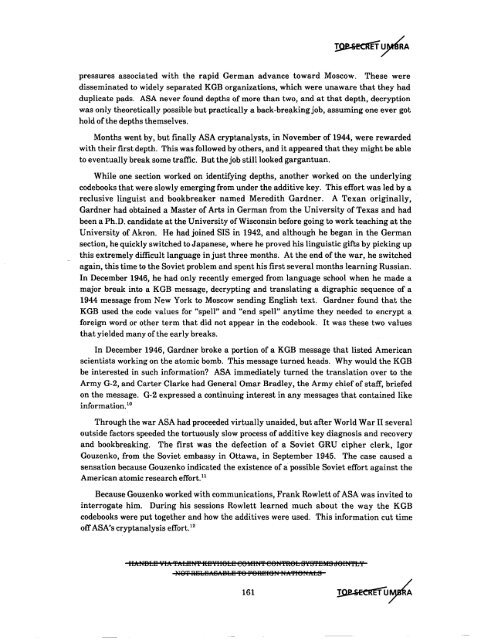American Cryptology during the Cold War - The Black Vault
American Cryptology during the Cold War - The Black Vault
American Cryptology during the Cold War - The Black Vault
Create successful ePaper yourself
Turn your PDF publications into a flip-book with our unique Google optimized e-Paper software.
pressures associated with <strong>the</strong> rapid German advance toward Moscow. <strong>The</strong>se were<br />
disseminated to widely separated KGB organizations, which were unaware that <strong>the</strong>y had<br />
duplicate pads. ASA never found depths of more than two, and at that depth, decryption<br />
was only <strong>the</strong>oretically possible but practically a back-breakingjob, assuming one ever got<br />
hold of<strong>the</strong> depths <strong>the</strong>mselves.<br />
Months went by, but finally ASA cryptanalysts, in November of 1944, were rewarded<br />
with <strong>the</strong>ir first depth. This was followed by o<strong>the</strong>rs, and it appeared that <strong>the</strong>y might be able<br />
to eventually break some traffic. But <strong>the</strong> job still looked gargantuan.<br />
While one section worked on identifying depths, ano<strong>the</strong>r worked on <strong>the</strong> underlying<br />
codebooks that were slowly emerging from under <strong>the</strong> additive key. This effort was led by a<br />
reclusive linguist and bookbreaker named Meredith Gardner. A Texan originally,<br />
Gardner had obtained a Master of Arts in German from <strong>the</strong> University of Texas and had<br />
been a Ph.D. candidate at <strong>the</strong> University ofWisconsin before going to work teaching at <strong>the</strong><br />
University of Akron. He had joined SIS in 1942, and although he began in <strong>the</strong> German<br />
section, he quickly switched to Japanese, where he proved his linguistic gifts by picking up<br />
this extremely difficult language in just three months. At <strong>the</strong> end of <strong>the</strong> war, he switched<br />
again, this time to <strong>the</strong> Soviet problem and spent his first several months learning Russian.<br />
In December 1946, he had only recently emerged from language school when he made a<br />
major break into a KGB message, decrypting and translating a digraphic sequence of a<br />
1944 message from New York to Moscow sending English text. Gardner found that <strong>the</strong><br />
KGB used <strong>the</strong> code values for "spell" and "end spell" anytime <strong>the</strong>y needed to encrypt a<br />
foreign word or o<strong>the</strong>r term that did not appear in <strong>the</strong> codebook. It was <strong>the</strong>se two values<br />
that yielded many of<strong>the</strong> early breaks.<br />
In December 1946, Gardner broke a portion of a KGB message that listed <strong>American</strong><br />
scientists working on <strong>the</strong> atomic bomb. This message turned heads. Why would <strong>the</strong> KGB<br />
be interested in such information? ASA immediately turned <strong>the</strong> translation over to <strong>the</strong><br />
Army G-2, and Carter Clarke had General Omar Bradley, <strong>the</strong> Army chiefof staff, briefed<br />
on <strong>the</strong> message. G-2 expressed a continuing interest in any messages that contained like<br />
information.10<br />
Through <strong>the</strong> war ASA had proceeded virtually unaided, but after World <strong>War</strong> II several<br />
outside factors speeded <strong>the</strong> tortuously slow process of additive key diagnosis and recovery<br />
and bookbreaking. <strong>The</strong> first was <strong>the</strong> defection of a Soviet GRU cipher clerk, Igor<br />
Gouzenko, from <strong>the</strong> Soviet embassy in Ottawa, in September 1945. <strong>The</strong> case caused a<br />
sensation because Gouzenko indicated <strong>the</strong> existence of a possible Soviet effort against <strong>the</strong><br />
<strong>American</strong> atomic research effort.a<br />
Because Gouzenko worked with communications, Frank Rowlett ofASA was invited to<br />
interrogate him. During his sessions Rowlett learned much about <strong>the</strong> way <strong>the</strong> KGB<br />
codebooks were put toge<strong>the</strong>r and how <strong>the</strong> additives were used. This information cut time<br />
offASA's cryptanalysis effort. 12<br />
IIJltfn~LI!JVIA 'fALI!Jlff l()i)YII6LI!J e6hIIN'f e6K'fft6L SYS'fI!JMS 66IN'fLY<br />
PO,S,+, RI!1J"Fh*,s"',BJ,,B 'fe peRBIaN Nlt'fIeNAbS<br />
161
















